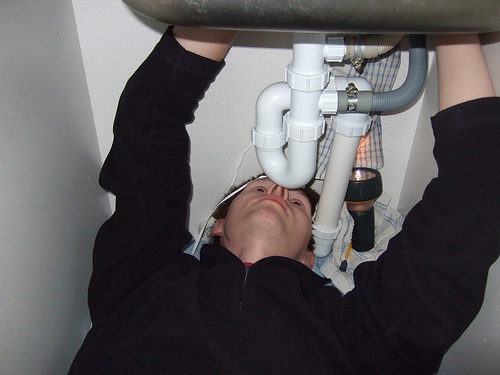
Often the drain will be narrow with a screen to catch debris. If this area has been cleared, but the drain remains slow or stopped, then a clog has formed in the U-trap or even farther down the pipes. In these cases a plunger or handheld drain auger is the proper tool for the job, but some clogs can be cleared without the need for either.
Utility basins are suited for clearing with a plunger, and if there is one available this should be the first thing tried. Unlike bathroom sinks with overflow drains, or kitchen sinks with a side branch, laundry sinks don’t have anywhere for the pressure created by the plunger to escape.
Sink plungers are the cartoonish red-rubber suction cup style plungers. Plungers meant for use on toilets can be used on sinks, but many households prefer separate plungers for separate duties. In any case, plunging a clogged utility sink is easy and straightforward. If there isn’t any water standing in the basin, add some for best chances of success with the plunger. The suction will be able to move the water against the clog and break the blockage down until it flows away.
Simply place the plunger over the drain in the standing water, holding it to form a tight seal between the basin and plunger cup. It is more important to maintain this seal than it is to use extreme force while plunging, so gently work the plunger a few times to bring the most amount of pressure down on the blockage. Check after a few strokes of the plunger for success, seeing if the water drains away. It may still be slow or stopped, and very stubborn clogs may take several attempts. But most laundry drains should be clear at this point.
If you’ve tried the plunger without success, or don’t have one handy, then something solid must be used to break up the clog or determine its location and composition.
Many home handheld drain augers have cables with small enough diameter to be threaded through the drain of utility sinks. Other times the U-trap will need to be removed and cleaned, which will provide access for the snaking farther down the line. In these cases, consult the manual or instructions for the drain auger.
Without a snake or plunger, there are still a couple things to try while waiting for those to arrive. Scalding hot water poured carefully down the drain may loosen greasy or oily build ups. Some clogs can be lubricated with a bit of liquid dishwashing soap before a hot water rinse. The final resort again is removal of the trap for inspection.
 Blue Donuts Plunger in Bronze Powder CoatThis is the perfect plunger for any home. Stylish design fits elegantly and discreetly in any style bathroom. This was designed to be used at any angle and fit snugly in any drain.
Blue Donuts Plunger in Bronze Powder CoatThis is the perfect plunger for any home. Stylish design fits elegantly and discreetly in any style bathroom. This was designed to be used at any angle and fit snugly in any drain.
 BAAM! Drain Blaster CleanerWorks on sinks, tubs, and toilets. Reusable, environmentally friendly, and easy to use.
BAAM! Drain Blaster CleanerWorks on sinks, tubs, and toilets. Reusable, environmentally friendly, and easy to use.
 TEKTON 36-Inch Claw Pick-Up Tool36 in. flexible spring steel shaft. Spring-loaded, 4-prong steel claw. Retrieves small, non-ferrous objects that magnets cannot
TEKTON 36-Inch Claw Pick-Up Tool36 in. flexible spring steel shaft. Spring-loaded, 4-prong steel claw. Retrieves small, non-ferrous objects that magnets cannot
Step-by-step instructions for making quick work of clogged or slowly flowing bathroom sink drains
UncloggingDrains101.comWhich Household Drain Problems Can Be Handled Without Calling A Pro?
UncloggingDrains101.comWhen clogs form in bathroom sinks, showers, bathtubs, kitchen & utility sinks, or shop & laundry drains—then the preferred tool will be a drain auger.
UncloggingDrains101.comDeciding when it is time to call in a professional, and tips for selecting the right drain service
UncloggingDrains101.comStep-by-step instructions for making quick work of clogged or slowly flowing bathroom sink drains
UncloggingDrains101.comEverything about unclogging floor drains, from the toughest job to the quickest maintenance
UncloggingDrains101.comLearn how to use the common drain snake and be prepared to do-it-yourself when it comes to slow or stopped drains in the home
UncloggingDrains101.com